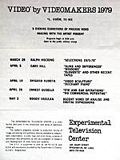History 1979-80
|
|
 |
The processing system computer is the Z-2, an 8 bit system with an S-100 bus, and dual floppy drives. A CAT digital frame buffer is interfaced to the computer; at the time this is one of the only commercially available "low-cost" digital devices which incorporated concepts of video, and recordable signal output. The Z-80 is interfaced also with the analog box. Software begins to be developed for specific video uses. Artists working in residence include Alan Powell and Connie Coleman, Charles Atlas, Victor Velt, Jud Yalkut and Ren Weidenaar. "The Electronic Workshop", a series of lecture/demonstrations concerning image processing, was presented for 17 organizations around New York State, The Center moves to Owego. |
History 1980-81
|
|

|
The need for artist-oriented software increases. The Print Program is developed by David Jones, allowing artists to develop videographic still frames, captured on disk, then printed out with variable gray level control. This is a natural extension of the use of video image processing as an "electronic darkroom" for photographic techniques, an area which was explored by a number of artists since the early 70s. Additional software is developed by graduate-level interns under the direction of Paul Davis and Ralph Hocking. Artists working at the Center include Dan Reeves and Jon Hilton, Celia Shapiro and Peter D'Agostino. |
  |
|
